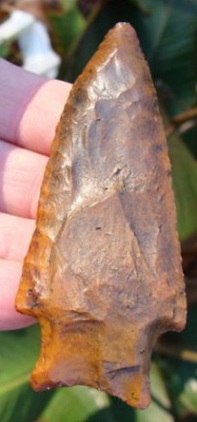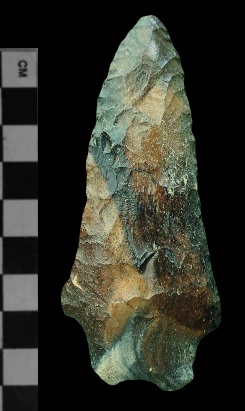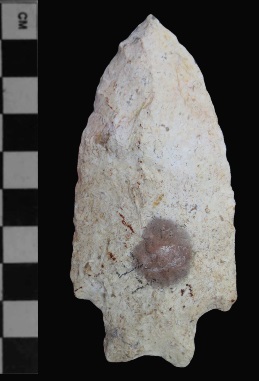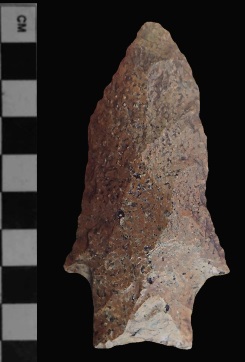Outline is Representative of Size and Shape:


Name Details:
Identified By: Ripley P. Bullen
Named For: Hamilton County, Florida
Date Identified: 1975
Type Site:
Identified By: Ripley P. Bullen
Named For: Hamilton County, Florida
Date Identified: 1975
Type Site:
Point Validity:
Valid type
Bullen was a distinguished anthropologist and Curator Emeritus of the Florida Museum of Natural History. He was dedicated to identifying and typing projectile points from Florida. This point was named in a professional publication and is professionally a widely recognized type. This is a valid type
Bullen was a distinguished anthropologist and Curator Emeritus of the Florida Museum of Natural History. He was dedicated to identifying and typing projectile points from Florida. This point was named in a professional publication and is professionally a widely recognized type. This is a valid type
Hamilton Concave Base
Cluster: Description of Physical Characteristics and Flaking Pattern:
This is a thick medium to large (3 to 5 inches) stemmed point with an elliptical cross section. The blade is broad with an excurvate shape. The blade may vary from being excurvate from the tip to the shoulder, or excurvate at the tip with the blade becoming almost parallel giving a lanceolate shape. The shoulders may vary from having an upward angel to horizontal. Some examples have a slightly barbed shoulder. The stem is broad and most commonly straight, but may vary to slightly contracting. The base is primarily concave, but may range to almost straight. The basal edges are rounded. This point has a random flaking pattern.
Size Measurements:
Total Length - 60 to 150 mm, Stem Length - 12 to 20 mm (average 15 mm), Blade Width - 30 to 50 mm, Stem Width 18 to 24 mm, Thickness - 9 to 14 mm, Basal Concavity - 1 to 3 mm
Total Length - 60 to 150 mm, Stem Length - 12 to 20 mm (average 15 mm), Blade Width - 30 to 50 mm, Stem Width 18 to 24 mm, Thickness - 9 to 14 mm, Basal Concavity - 1 to 3 mm
Commonly Utilized Material:
Cherts and Coral
Cherts and Coral
Additional Comments:
This should not be confused with the Hamilton Stemmed point found in the Tennessee River valley. That point is a Woodland point where this is an Early Archaic point. This point is similar in appearance to the newer Savannah River point (Granger and Granger, 2013).
Bullen (1975) distinguished these points from Arredondo points, noting that the Arredondo points have a weaker shoulder, a deeper basal concavity, and are generally thicker. Many other researchers feel that the difference between the two types rely solely on the depth of the basal concavity. Farr (2006) feels that this is chimerical (a product of the imagination), noting that the two types are stratigraphic co-occurrence in Florida archaeological contexts.
See link below for additional examples:
http://www.flmnh.ufl.edu/flarch/bullen/hamilton.htm
This should not be confused with the Hamilton Stemmed point found in the Tennessee River valley. That point is a Woodland point where this is an Early Archaic point. This point is similar in appearance to the newer Savannah River point (Granger and Granger, 2013).
Bullen (1975) distinguished these points from Arredondo points, noting that the Arredondo points have a weaker shoulder, a deeper basal concavity, and are generally thicker. Many other researchers feel that the difference between the two types rely solely on the depth of the basal concavity. Farr (2006) feels that this is chimerical (a product of the imagination), noting that the two types are stratigraphic co-occurrence in Florida archaeological contexts.
See link below for additional examples:
http://www.flmnh.ufl.edu/flarch/bullen/hamilton.htm
Distribution: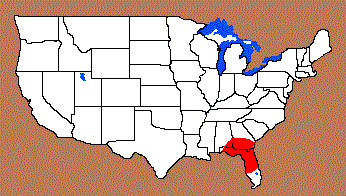

Distribution Comments:
This point is primarily found in central to northern Florida and into southern Georgia and southeastern Alabama.
This point is primarily found in central to northern Florida and into southern Georgia and southeastern Alabama.
Age / Periods:
Date: 8,000 - 6,000 B.P.
Cultural Period: Early to Middle Archaic
Glacial Period: Middle Holocene
Culture:
Date: 8,000 - 6,000 B.P.
Cultural Period: Early to Middle Archaic
Glacial Period: Middle Holocene
Culture:
Age Details:
Bullen (1975 felt that these were an intermediate form between the Kirk Serrated and the Arredondo types. Farr (2006) notes that these two points have been found within the same strata at many Florida sites and feels that these are coevals.
Bullen (1975 felt that these were an intermediate form between the Kirk Serrated and the Arredondo types. Farr (2006) notes that these two points have been found within the same strata at many Florida sites and feels that these are coevals.
Similar Points:
Arredondo, Columbia, Elora, Kirk Stemmed, Savannah River, Seminole, Thonotosassa, Wacissa
Arredondo, Columbia, Elora, Kirk Stemmed, Savannah River, Seminole, Thonotosassa, Wacissa
Other points in this cluster / Related / Associated Points:
Appalachian, Holms (Savannah River Narrow Stem), Savannah River
Appalachian, Holms (Savannah River Narrow Stem), Savannah River

